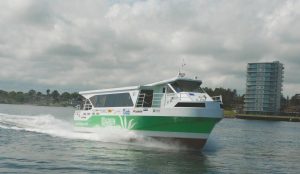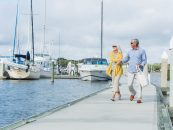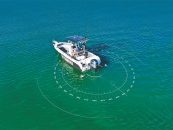Article by Andrew Bedggood
Marine electric motor technology has improved markedly since the first documented trip by an electric boat, designed by the Russian inventor Jacobi, which crossed the Neva River in 1838 carrying 14 passengers.
Largely influenced by concern for the environment, advancements in electric powered engines design seem to be progressing rapidly. Electric boat motors, which are still expensive compared to petrol and diesel varieties, offer many features that combustion engines do not – quite apart from a massive reduction in noise, air, and water pollution, and significantly reducing carbon emissions – one big advantage is instant torque – even when the motor is turning so slowly that you can clearly observe the individual propeller blades.
With initially expensive new technologies, it is governments and then commercial interests that are first to dip their toes in the water, but if there were any concerns about the power of electric marine motors, then the performance of the Ellen Electric Ferry, which was the largest all-electric ferry in 2019, the year it entered service, should lay them to rest. It operates a 22 nautical mile route between Søby and Fynshav in Southern Denmark. Each round trip uses 1/3 of the battery capacity, using top-up charging during a 5-6 trip day. Although it cost 40% more to develop and build than a conventional ferry, the annual operating costs are 75% lower with 2000 tonnes less CO2 emissions per year. It was built using aluminium for the bridge, and furniture made from recycled cardboard, to keep the weight low. It is 59.4 m long, 12.8 m wide, with a gross weight of 996 tonnes, and maximum speed of 14.2 kn. The carrying capacity is around 30 cars and up to 200 passengers. It is driven by two 700 kW electric motors which are powered by a 4.3 MWh battery. There is no emergency generator.
Besides Denmark, both all-electric and hybrid ferries are entering service in many countries now: Canada, the United States (notably Washington State Ferries), Sweden, Norway, Thailand, Ireland, Malta, and Greece.
The BB Ferry from Stockholm-based Green City Ferries is 24.8 m long, with a beam of 7.5 m. It weighs 28 tonnes and can carry 147 seated passengers, cruising at 26 kn. It uses 25 kWh per nm supplied by its 500 kWh lithium titanate oxide battery cells, which can be fully recharged from empty in under 20 minutes.
Bangkok’s new passenger ferries gained enthusiastic support from the government after a 2018 experiment in which the 205 hp diesel on an existing 40 passenger river ferry was replaced with twin Torqeedo Cruise 10 kW electric outboards, along with a dozen lithium-ion batteries and four fast chargers. That successful trial led to the conversion of the whole ferry fleet.
 Of course, relatively short ferry trips of 20 – 30 nm are one thing, but what about more substantial journeys? The German company, Silent Yachts, which produces a range of catamarans, decided to put their diesel/electric Solarwave 62 to the test in 2018.
Of course, relatively short ferry trips of 20 – 30 nm are one thing, but what about more substantial journeys? The German company, Silent Yachts, which produces a range of catamarans, decided to put their diesel/electric Solarwave 62 to the test in 2018.
The hybrid luxury yacht successfully crossed the Atlantic Ocean from Spain to Miami. She made the crossing mainly using solar power, supported by about 0.12 litres of diesel per kilometre for the generator, recharging the batteries when there was insufficient sunlight. The yacht boasts four cabins and four bathrooms, a high-quality kitchen with induction cooking, an ice-maker, a washing machine, and even a desalination plant. Two lithium-ion batteries with a capacity of 160 kWh supply all the boat’s electrical needs, and power the four 22 kW motors used for propulsion.
Many readers may not be planning to sail across an ocean anytime soon, but rest assured that there are ongoing developments occurring with smaller all-electric vessels. To get the most out of the new technology, boat manufacturers are streamlining their vessels, using lighter materials, and ensuring that draft is minimised.
 There is plenty of money being invested in electric boat development. Recently, Swedish e-boat company X Shore and Hong Kong electric boat manufacturer ePropulsion received the equivalent of $18M USD and $15M USD, respectively. Other companies to raise funds are Vision Marine Technologies $27.5M, Oceanvolt $2.7M, DeepSpeed $3.5M, and Pure Watercraft $37.5M. That is more than $100M USD through grants and crowd funding activities, without accounting for donations from groups and individual investor/entrepreneurs with an interest in sustainability and preserving the environment.
There is plenty of money being invested in electric boat development. Recently, Swedish e-boat company X Shore and Hong Kong electric boat manufacturer ePropulsion received the equivalent of $18M USD and $15M USD, respectively. Other companies to raise funds are Vision Marine Technologies $27.5M, Oceanvolt $2.7M, DeepSpeed $3.5M, and Pure Watercraft $37.5M. That is more than $100M USD through grants and crowd funding activities, without accounting for donations from groups and individual investor/entrepreneurs with an interest in sustainability and preserving the environment.
Swedish firm X Shore have produced the Eelex 8000 – an 8m all-electric mono-hulled ‘smart’ boat which can be controlled remotely by mobile phone. A 225 kW (300 hp equivalent) electric motor, powered by dual 60 kWh Li-ion batteries can push the boat to 35 kn, but a more sedate 4 kn can deliver 160 km of travel spread over 20 hours. The lifespan for the batteries has been estimated at 30-60 years. They can be recharged in 5-6 hours from a 240V AC power outlet, or 1-2 hours using a DC fast charger. The boat weighs only 2600 kg including batteries. The cost to recharge is about 1/10 the price of a full tank of petrol/diesel. The Eelex 8000 is currently not fitted with solar panels, but the company is investigating that option.
If you do not have a lazy $300,000 to $400,000 to spend on the Eelex 8000, perhaps upgrading your petrol/diesel motor(s) to a clean, green, and quite powerful electric motor could be a viable alternative.
Of the companies which manufacture electric boat engines, and distribute globally, perhaps the best known is Torqeedo which was founded in 2005 and delivered their 100,000th motor in 2020. Torqeedo has a range of motors to suit anything from fishing kayaks, tenders, light freshwater fishing boats, to sailboats, motorboats, and other vessels up to 10,000 kg.
Two of Torqeedo’s powerful Deep Blue 80 motors (80 hp equivalent) are used on the Canadian built 8.8-metre, 2,000 kg, Phoenix 290 with energy supplied by two BMW i3 batteries, which will last 2 to 3 hours at 17 kn (cruising), and all day at 5 to 7 kn.
Steven Mullie, of Eco Boats, explains that electric motors are at least as powerful as internal combustion engine (ICE) alternatives, but are much quieter, considerably more environmentally friendly, and far more responsive. The only problem Steve sees is the size of the battery array required to allow larger boats to run at speed for a substantial amount of time. There has been steady improvement, but no technological breakthrough yet, which addresses this issue. He laments the fact that people still use their fossil fuel guzzling ICEs, which lose over 90% of their energy as unproductive heat, in preference to electric motors which transfer 95% of battery energy to moving the boat. Steven sees a bright future for lightweight full-electric multi-hull style power boats, with large solar arrays, that can cruise long range at moderate speed. Eco Boats is working with companies which are developing this type of vessel by supplying the technology for their electric drive systems.
While battery technology is slowly improving, electric boat motor design is making great advances with one of the most impressive being the departure, by an Italian firm, from the concept of propeller driven watercraft to vastly more efficient electric hydro jet propulsion technology, much like the change that occurred in aeronautics mid last century.
Published in print July-September 2021



























